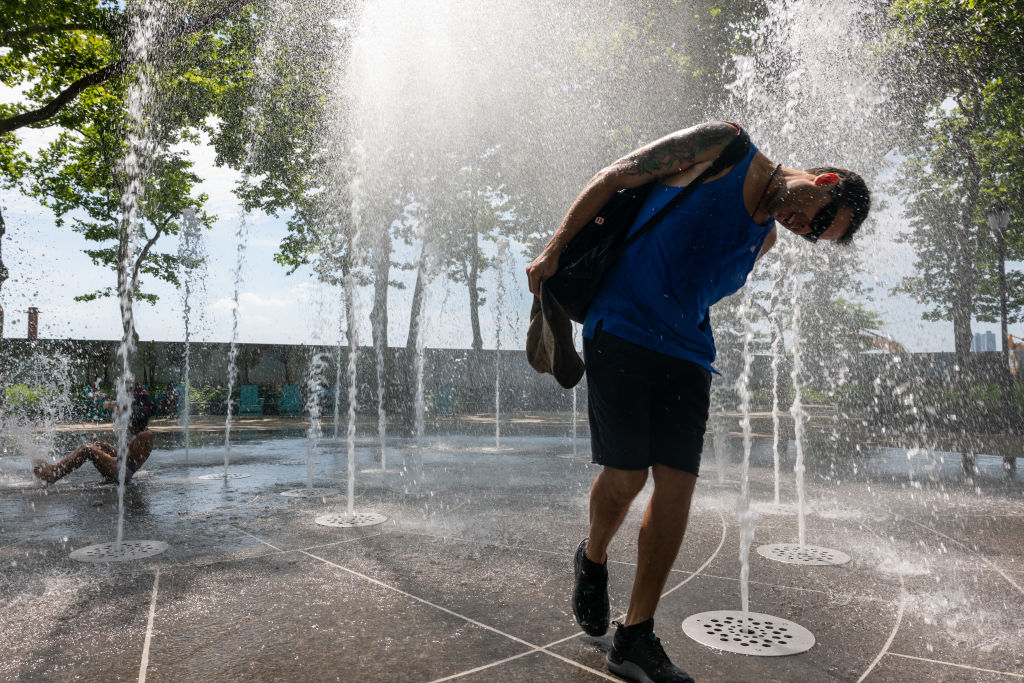A man cools off in a fountain in Manhattan on a sweltering afternoon on the first day of summer on June 20, 2024 in New York City. New York City and much of the Northeast is experiencing higher than usual temperatures as a heat wave blankets the area causing the heat index to feel over 100 degrees in many states. Meteorologists are predicting that this could be one of the hottest summers on record. (Spencer Platt/Getty Images)
The first two heat-related deaths in Idaho this year have been reported to the Division of Public Health. Both Idaho residents who died were over the age of 60.
“Please stay safe if you head outdoors this summer,” said Dr. Christine Hahn, Idaho public health medical director, in a press release announcing the deaths. “Stay hydrated, wear sunscreen and a hat with a brim, and be aware that even if it’s cool in the morning, temperatures can rise a lot during the day this time of year.”
Hahn encouraged people to stay safe as temperatures, which could reach the high 90s or near 100 degrees, are expected to soar this weekend, especially in the southern portion of the state.
Anyone can get heat-related illness, the press release said, but those at greater risk are young children, older adults, and people who are overweight or have underlying health conditions or take certain medications that reduce the body’s ability to stay cool.
Be aware of symptoms of heat-related illness and how to treat them
The most serious type of heat-related illness is heatstroke, which is a medical emergency.
Symptoms may include:
high body temperature
hot red skin
confusion or seizures
nausea, dizziness and fainting
If someone experiences these symptoms and cannot quickly get medical care, health officials urge you to call 911 right away. Move to a cooler place and use cool wet cloths or ice on the head, neck, armpits and groin, or soak clothing with cool water or give a cool bath to help lower body temperature. Speed cooling with a fan. Do not give a person with heatstroke anything to drink, as they may not be able to swallow correctly and could inhale the fluid instead of swallowing it.
Heat exhaustion may occur before symptoms of heatstroke, health officials said in the press release. Symptoms may include tiredness, weakness, irritability, thirst, headache, nausea, muscle cramps and cold, clammy skin. Someone experiencing these symptoms should move to a cool place, loosen clothes, use cool cloths or a cool bath to help lower body temperature, and sip cool water frequently. Get medical help right away if vomiting starts, symptoms get worse, or symptoms last longer than an hour.
The best ways to prevent heat-related illness include staying cool and well-hydrated, health officials say
To prevent heat-related illness:
Wear lightweight, loose-fitting clothing
Limit outdoor activity to the coolest hours of morning and evening
Stop activity and get into shade if your heart is pounding and you are gasping for breath
Avoid hot and heavy meals
Drink plenty of fluids — at least one cup of water every 15–20 minutes for moderate activities lasting less than two hours. Don’t wait until you are thirsty to drink.
Avoid alcohol and drinks with high caffeine or sugar
Replace salt and minerals with a low-sugar sports drink. Talk to your doctor first if you are on a low-salt diet, have diabetes, high blood pressure, or other chronic conditions.
Wear a wide-brimmed hat, sunglasses, and wear sunscreen with an SPF of 15 or higher. Reapply sunscreen if you will be outside longer than two hours.
GET THE MORNING HEADLINES DELIVERED TO YOUR INBOX
The post First heat-related deaths reported in Idaho this year, public health officials say appeared first on Idaho Capital Sun.

